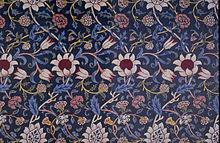
Back طباعة النسيج Arabic Potiskování textilií Czech Textildruck German Estampado textil Spanish چاپ پارچه Persian Kankaanpainanta Finnish Impression textile French छपाई (वस्त्रों की) Hindi Stampa tessile Italian დაჩითვა Georgian
This article is largely based on an article in the out-of-copyright Encyclopædia Britannica Eleventh Edition, which was produced in 1911. (October 2020) |





Textile printing is the process of applying color to fabric in definite patterns or designs. In properly printed fabrics the colour is bonded with the fibre, so as to resist washing and friction. Textile printing is related to dyeing but in dyeing properly the whole fabric is uniformly covered with one colour, whereas in printing one or more colours are applied to it in certain parts only, and in sharply defined patterns.[1]
In printing, wooden blocks, stencils, engraved plates, rollers, or silkscreens can be used to place colours on the fabric. Colourants used in printing contain dyes thickened to prevent the colour from spreading by capillary attraction beyond the limits of a pattern or design.
- ^ Knecht & Cole 1911, p. 695.